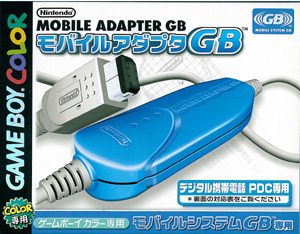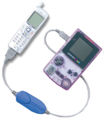Mobile Game Boy Adapter

|
This article is incomplete. Please feel free to edit this article to add missing information and complete it. Reason: Appearance in Pokémon Adventures manga (used by Crystal) |
The Mobile Game Boy Adapter[1] (Japanese: モバイルアダプタGB Mobile Adapter GB) is a peripheral for the Game Boy Color, Game Boy Advance, and Game Boy Advance SP which allows players to connect to compatible Japanese mobile phones. The peripheral was a collaboration between Nintendo and Mobile21, a company that was jointly owned by Nintendo and Konami.
It was first released on January 27, 2001 (originally planned for December 2000[2][3]) with a recommended retail price of ¥5800, before a price cut to ¥3800 from July 19, 2001.[4] By late March 2001, Nikkei reported that Nintendo had only sold 80,000 units; the reason provided was that the only game to extensively use the Mobile Game Boy Adapter at the time was Pokémon Crystal, which was targeted at a younger audience whom may not have access to a mobile phone.[5]
Pokémon Mobile System GB
- Main article: Pokémon Mobile System GB
As a part of a service known as Mobile System GB (Japanese: モバイルシステムGB Mobile System GB), the Mobile Game Boy Adapter provided the hardware to compatible games, which used the network for wireless play across the nation via the now defunct gameboy.datacenter.ne.jp server, hosted by Nintendo Network Service Development. KDDI was the internet service provider of the Mobile System GB's network. The most well-known Mobile System GB is the Pokémon Mobile System GB used in the Japanese releases of Pokémon Crystal and Pokémon Stadium 2.
Despite its promises, the service was not much of a commercial success and closed down on December 14, 2002,[6] probably due to the additional costs involved and the target audience of its biggest user (Pokémon Crystal) being off-limits. The closure of the Mobile System GB service makes it impossible for players to link to the server; however, it is still possible to link with friends provided that a peer-to-peer network is used.
Package
The package was bundled with the original Mobile Game Boy Adapter itself, which was a blue cable that could be used to connect to compatible Japanese mobile phones. Included with the Mobile Game Boy Adapter is the "Mobile Trainer" cartridge, that only boots up when the Mobile Game Boy Adapter is connected to a compatible Japanese mobile phone. A special edition of the Mobile Game Boy Adapter came packaged with Mobile Golf, which was a spin-off to the Mario Golf series used to test the Mobile Game Boy Adapter. After the Mobile Game Boy Adapter's release, different colored cables were sold separately which allows the player to connect to different types of phones, one of which was announced but never released.
Cables
In addition to the blue Mobile Game Boy Adapter cable, three other cables were announced, all of which were sold separately, apart from the green adapter, which was never released. They all allowed the player to connect to different types of phones.
- Blue: the original cable packaged with the Mobile Game Boy Adapter. Supports connections to a digital cell phone terminal PDC. The cable allowed for a maximum bit rate of 9600 bits per second (bps).
- Yellow: this cable connects to a cdmaOne mobile phone, allowing for a maximum bit rate of 14.4 kilobits per second (kbps).
- Red: this cable connects to a DDI mobile phone, with a maximum bit rate of 36.6 kilobits per second (kbps).
- Green: this cable would have support PHS devices from Astel and NTT DoCoMo, but it was ultimately never released.
The different cables as seen in a commercial
Mobile Trainer
Mobile Trainer (Japanese: モバイルトレーナー Mobile Trainer) is a cartridge which came packaged with the Mobile Adapter GB itself, developed by MissingLink, the parent company of Denyusha.[7] Prior to its release, it was previously given the tentative name of Mobile Starter Cartridge (Japanese: モバイルスターターカートリッジ Mobile Starter Cartridge).[8] The cartridge served as a general guide to the Mobile System GB, which included a help menu about how to use the service and a glossary of key terms. Under a mobile settings menu, the player was able to alter their registration details, and confirm their remaining balance.
When the player boots up the cartridge, a connection screen checks whether the Mobile Game Boy Adapter is connected. The software will progress past the loading screen only once connected to a compatible Japanese mobile phone. The cartridge offered an email system in which users could exchange text messages between each other. Another feature of the Mobile Trainer cartridge was access to the Mobile System GB homepage, which published featured articles around different compatible titles.
In the internal data of the Mobile Trainer ROM, graphics for Pokémon such as (but not limited to) Pikachu, Porygon2 and Tyranitar have been found, as well as a test message about an alleged 'Pokémon game' which was never released known as Pokémon Moss (Japanese: ポケットモンスター苔). The purposes of these graphics are unknown.
(Hidden Pokémon content covered in below video at 28:48)
| |
List of compatible software
Below is a list of all Game Boy Color and Game Boy Advance software which supported the Mobile System GB.[9] Although five of these games (Pokémon Crystal, Napoleon, Top Gear GT Championship, Mario Kart: Super Circuit, and ESPN Great Outdoor Games Bass 2002) were released outside of Japan, only the Japanese versions were compatible with the Mobile Adapter.
| Title | Console | Developer | Publisher | Release date |
|---|---|---|---|---|
| Pokémon Crystal Version (ポケットモンスター クリスタルバージョン Pocket Monsters: Crystal Version) |
Game Boy Color | Game Freak | Nintendo | December 14, 2000 |
| Mobile Trainer (モバイルトレーナー) | Game Boy Color | MissingLink | Nintendo | January 27, 2001 |
| Monster Guardians (モンスターガーディアンズ) | Game Boy Advance | Mobile21 | Konami | March 21, 2001 |
| Napoleon (ナポレオン) | Game Boy Advance | Genki | Nintendo | March 21, 2001 |
| Play Novel: Silent Hill (プレイノベル サイレントヒル) | Game Boy Advance | Konami | Konami | March 21, 2001 |
| Top Gear GT Championship (全日本GT選手権 All-Japan GT Championship) |
Game Boy Advance | Vision Works | Kemco | March 21, 2001 |
| Doraemon: Midori no Wakusei Doki Doki Daikyūshūtsu! (ドラえもん 緑の惑星ドキドキ大脱出!) | Game Boy Advance | Mobile21 | Epoch | April 27, 2001 |
| Mobile Golf (モバイルゴルフ) | Game Boy Color | Camelot | Nintendo | May 11, 2001 |
| Morita Shōgi Advance (森田将棋あどばんす) | Game Boy Advance | Yuki Enterprise | Hudson Soft | July 12, 2001 |
| Net de Get Minigames @100 (ネットでゲットミニゲーム@100) | Game Boy Color | Mobile21 | Konami | July 12, 2001 |
| EX Monopoly (EXモノポリー) | Game Boy Advance | Mobile21 | Takara | July 13, 2001 |
| Mario Kart: Super Circuit (マリオカートアドバンス Mario Kart Advance) |
Game Boy Advance | Intelligent Systems | Nintendo | July 21, 2001 |
| JGTO Licensed: Golfmaster Mobile (JGTO公認 GOLFMASTERモバイル) | Game Boy Advance | Konami | Konami | July 26, 2001 |
| Kinniku Banzuke ~Kongō-kun no Daibōken!~ (筋肉番付~金剛くんの大冒険!~) | Game Boy Advance | KCE Studios | Konami | July 26, 2001 |
| Mobile Pro Baseball: Control Baton (モバイルプロ野球 監督の采配) | Game Boy Advance | Mobile21 | Konami | July 26, 2001 |
| Starcom: Star Communicator (スタコミ STAR★COMMUNICATOR) | Game Boy Advance | Konami | Konami | July 26, 2001 |
| Zero-Tours (ゼロ・ツアーズ) | Game Boy Advance | Amedio | Media Rings | July 27, 2001 |
| Game Boy Wars 3 (ゲームボーイウォーズ3) | Game Boy Color | Hudson Soft | Nintendo | August 30, 2001 |
| ESPN Great Outdoor Games Bass 2002 (エキサイティングバス Exciting Bass) |
Game Boy Advance | Konami | Konami | November 29, 2001 |
| Daisenryaku For Game Boy Advance (大戦略 For ゲームボーイアドバンス) | Game Boy Advance | SystemSoft Alpha | Media Kite | December 7, 2001 |
| Mail de Cute (メールでキュート) | Game Boy Advance | Mobile21 | Konami | February 14, 2002 |
| Hello Kitty: Happy House (ハローキティのハッピーハウス) | Game Boy Color | MTO | MTO | March 2, 2002 |
| beatmaniaGB Net Jam (beatmaniaGBネットジャム) | Game Boy Color | Konami | — | Cancelled |
| Horse Racing Creating Derby (馬穴大作戦)[10][11][12] | Game Boy Advance | Nintendo | — | Cancelled |
Similar devices
The Mobile Game Boy Adapter was not the first Game Boy peripheral offering online play. From as early as March 6, 1998, Hudson Soft's GB Kiss Link Modem allowed players to access downloadable content from the Internet and send messages between friends, through a number of compatible games which had built-in infrared ports, such as Nectaris GB, the Japanese versions of Robopon for the Game Boy Color, as well as the GB Kiss Minigames cartridge which came packaged with the GB Kiss Link Modem. The Link Modem was available through mail order.
References
- ↑ Iwata Asks - Personal Trainer: Walking (archived copy)
- ↑ Mobile Adapter GB Delayed - GameSpot (archived copy)
- ↑ Game Boy Mobile Adapter Delayed (archived copy)
- ↑ DMG/MGB/CGB: ゲームボーイ
- ↑ Low Numbers for Mobile Adapter GB - IGN (archived copy)
- ↑ モバイルシステムGB
- ↑ ShadowFlare
- ↑ モバイルトレーナー
- ↑ モバイルシステムGB対応ソフト
- ↑ Horse Racing Creating Derby - IGN
- ↑ ファミ通.com ゲーム/馬穴大作戦
- ↑ Game Boy.com - Baketsu Daisakusen (Horse Racing Game)
External links

|
This game mechanic article is part of Project Games, a Bulbapedia project that aims to write comprehensive articles on the Pokémon games. |



